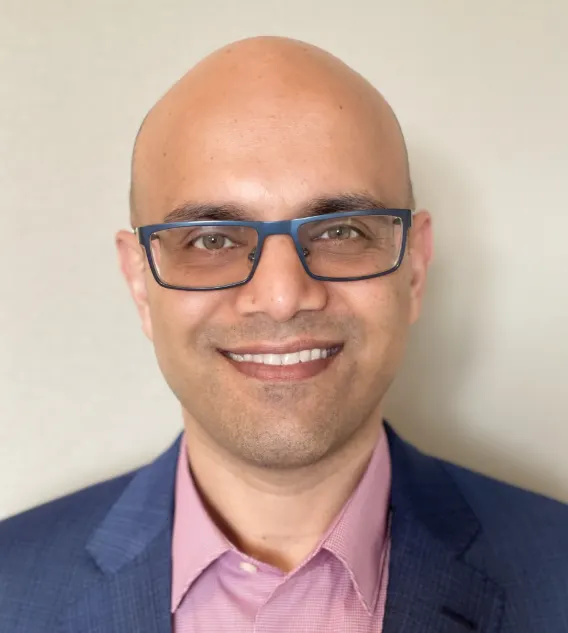Taking a company public is often framed as the finish line, but for finance leaders, it is just the start of a new set of challenges. Navigating investor expectations, balancing growth with profitability and managing liquidity in volatile markets all become daily concerns after the IPO celebration fades.
Nitesh Sharan, CFO of SoundHoundAI, faced those realities in 2022 when the voice-AI company went public during one of the most challenging market environments in recent memory. A veteran of Hewlett Packard and Nike, Sharan entered the role eager to move from sustaining legacy enterprises to building a disruptive business at the center of a global trend.
In this conversation with CFO.com, Sharan reflects on life after the firm’s IPO, the hunt for profitability, the evolution of AI inside the finance function and what it means to oversee not only finance but also HR and legal at a fast-growing public company.
Nitesh Sharan

CFO, SoundHound AI
First CFO Position: 2020
Notable previous employers:
- Nike
- Hewlett Packard
- Accenture
This interview has been edited for brevity and clarity.
ADAM ZAKI: I find life after IPO is rarely discussed. You accomplish this big goal, but you can’t just stop there. How did you keep your teams motivated and growth-oriented during that time?
Nitesh Sharan: I grew up a “mega cap” company guy. I started my career in consulting, then spent several years at Hewlett Packard before moving to what was truly a dream job at Nike. As someone from Cleveland, where the sports history is mostly heartbreak, being at Nike right as the Cavaliers won the NBA championship was surreal.
I loved Nike, but I wanted to be where the world was moving. I have kids, and I kept thinking about where the real tail winds were. AI was clearly one of those trends, and it’s catalyzed even faster than I imagined when I signed on here. So, I joined SoundHound AI, a smaller company, but one with a disruptive vision. I knew that going public would be one mile marker on a much longer journey of growth and disruption.
The IPO itself came at the most difficult time in a generation to go public. Interest rates were rising, the liquidity environment was incredibly tough and we were in a hypercompetitive next-gen tech space. But we believed in our mission: to create voice AI that allows people to interact naturally with technology. Instead of typing on a phone or clicking menus, why not just talk and get things done? Filing an insurance claim, ordering food, navigating your car—our vision is that those things should all happen through natural conversation.
The IPO day was a huge milestone, but for me personally, it was also about stewardship. Our founders had been at this for over a decade, and the team had stuck together through thick and thin. I felt my role was to help deliver that moment with them, then keep us moving forward. And moving forward wasn’t easy, capital raising was tough, investor attention was hard to capture and as a public company, you’re suddenly layering quarterly reporting on top of all the existing challenges.
I kept my team motivated by constantly reinforcing that the IPO isn’t the destination. It’s just one milestone on a bigger path of building a sustainable, disruptive company. The focus had to shift right back to growth, resilience and execution almost immediately.
When I go into trade shows, every company is “.ai” now. Your organization has had this nomenclature for a while. Do you find yourself “selling” the idea of AI’s benefits internally?
Adding “.ai” to your name feels like adding “.com” in the early internet days. A lot of companies do it because it signals relevance. But we’ve been building AI long before it became trendy. Our foundations go back to the early 2000s, when our co-founders were PhD and computer science students at Stanford doing dissertations in speech recognition and machine learning. That was before the iPhone even existed.
We were quick to adopt deep learning when it emerged in the 2010s, and now we’re deeply invested in large language models and transformer architectures. So for us, AI isn’t a buzzword. It’s who we’ve always been.
Internally, that means there’s very little “selling” to do. Our people live and breathe AI. Most of them have spent their entire careers pushing the boundaries of conversational technology. In fact, what I appreciate most about being here is that when I read about the latest hype in AI and wonder what’s real and what’s fluff, I can just walk down the hall and ask our engineers. They’ll tell me exactly where the breakthroughs are, and where the smoke and mirrors are.
“Right now, our top five priorities are growth, growth, growth, growth and profitability — in that order.”

Nitesh Sharan
CFO, SoundHound AI
The harder challenge isn’t convincing people that AI matters. It’s figuring out where to focus when there are 50 promising directions you could go. Prioritization is the hard part. But the passion for AI as a force for good and a transformative technology is baked into our DNA.
You oversee finance, HR and legal — more than most public company CFOs I’ve interviewed. How do you balance your time across those functions?
I tend not to think about it [in terms of] percentages of time. To me, it’s about being in service to the company’s broader mission. The evolution of the CFO role has been moving this way for a while. At different points in time, CFOs were accounting or treasury experts or FP&A leaders. Today, the role is much more about being a strategic partner across the business.
My framework is: Do the fiduciary basics, allocate capital wisely and manage risk. That translates into everything from reviewing attrition data in HR to weighing in on the revenue recognition aspects of a complex deal to helping shape our M&A strategy.
I’m fortunate to have strong leaders in each of these areas. My job is to make sure their work is aligned with the company’s top priorities. And right now, our top five priorities are growth, growth, growth, growth and profitability — in that order. We want to maintain hypergrowth while moving toward break-even, and every function has a role in that.
So the way I divide my time depends on what the business needs most urgently in a given week. Sometimes it’s capital raising. Sometimes it’s a big HR decision. Sometimes it helps legal navigate a new regulatory question. It’s fluid but always anchored in growth and sustainability.
Is there an area of business where you’d like finance to have a bigger role over the next year?
That’s something we’ve been discussing internally. Instead of thinking about finance expanding its footprint as a function, I think about spreading financial acumen across every part of the business.
Ultimately, every decision has a cost and a return. Marketing must evaluate the ROI of every conference or campaign. Engineering must balance big innovation bets, knowing some will fail [while] others will define the company’s future. Sales must weigh direct versus indirect channels and the efficiency of each.
Finance can be the red thread that ties those decisions together. Sometimes that means embedding financial expertise inside functions. At other times, it means building up centralized FP&A. Either way, the goal is the same: Bring rigor and clarity to the opportunity costs and returns of every decision.
And then there’s the AI angle. I don’t think the future is about adding more people to finance. It’s about equipping everyone in the company with tools that can help them make better financial decisions in real time. Imagine a sales leader having a conversation with a chatbot that can evaluate whether attending a particular trade show is a good investment. That’s where I think we’re headed.





